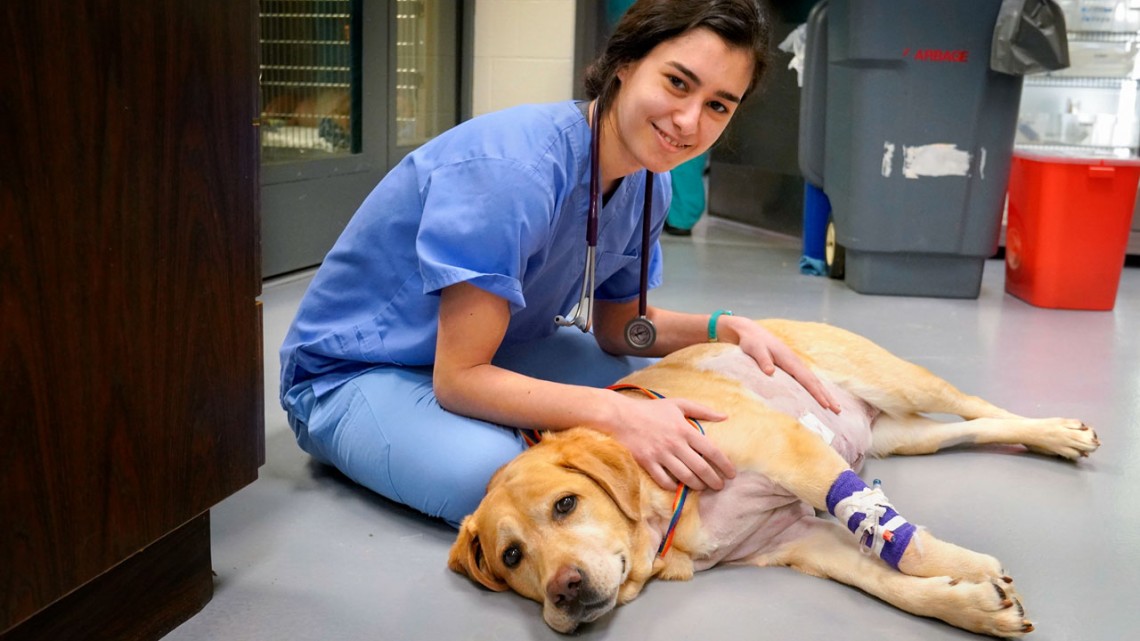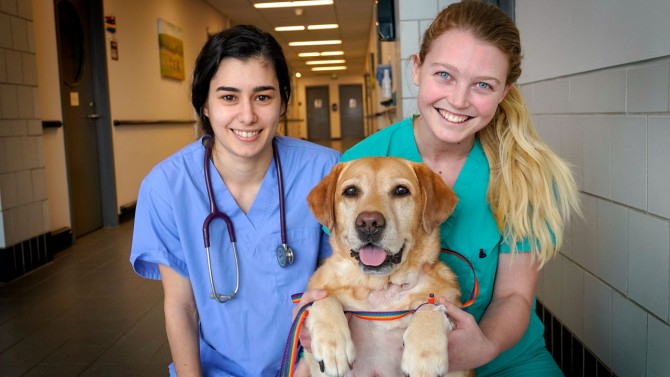
Fourth-year veterinary student Sara Cantini was an observer during the rare canine open-heart surgery, and was one of Lucy's caretakers at the Cornell University Hospital for Animals.
Veterinarians, MDs team up for canine open-heart surgery
By Melanie Greaver Cordova
Imagine the time it takes to brew some coffee, answer an email or take out the trash – approximately five minutes, maybe less.
In that amount of time, Cornell veterinarians and human medicine physicians performed open-heart surgery on a canine patient, removing a tumor blocking the right ventricle.
Lucy, a 7-year-old yellow Labrador retriever, started fainting regularly late last year. Her owners, the Baginski family, were concerned.
“There were a few times when she became disoriented, and others when she’d get excited while playing but then fall to the floor,” said David Baginski, who lives in the Rochester area with Lucy and his family.
The Baginskis were referred to the Cornell College of Veterinary Medicine (CVM). There, the cardiologists carried out a 3D echocardiogram that revealed the tumor.
“Lucy was periodically collapsing and essentially blacking out because of her heart’s failure to oxygenate,” said Dr. Galina Hayes, assistant professor of small animal surgery. “The mass was blocking the outflow of blood. If you imagine the ventricle is like a pump, it would be as if something got caught in the hose.”
The veterinarians were concerned that even if the cancer itself wasn’t terminal, the effects of the tumor could be. The Baginskis agreed, thinking that one day Lucy wouldn’t wake up from a faint. “At first we thought she was just out of shape,” Baginski said. “We’d have to encourage her to keep up on walks, but now we know it was a circulation problem and she was getting tired.”
Hayes conferred with colleagues at the Cornell University Hospital for Animals on the best approach to remove the mass. “I’ve never seen a case like this in my career,” Hayes said. “There is maybe a total of three such reported cases in veterinary literature.”
One of the experts Hayes brought in was Dr. Luis Campoy, associate clinical professor and section chief of anesthesiology and pain medicine.
“I was on the phone with Dr. Hayes, and we knew we had to do something quickly, otherwise Lucy might not survive,” Campoy said. “If we waited too long to decide what to do she could be gone.”
Campoy reached out to his counterparts at the Weill Cornell Medicine Department of Anesthesiology in New York City to brainstorm options.
Partnering with Weill Cornell Medicine is not new for the Ithaca veterinary anesthesia team. For the last five years, CVM and Weill Cornell Medicine have engaged in an elective rotation for their respective anesthesiology residents. Dr. Maria Walline, a cardiothoracic anesthesiology fellow with Weill Cornell Medicine, jumped on an early morning shuttle bus from New York City to assist with Lucy’s anesthesia.
“We knew this would be a high-risk procedure, riskier than it would be with a human patient because it was not possible to use cardiopulmonary bypass for Lucy,” Walline said. “The patient profiles are similar in pediatric and veterinary anesthesia – you are treating a patient, typically smaller in size than an adult, who is nonverbal.”
Open-heart surgeries are more common in human patients, largely due to human hospitals’ access to cardiopulmonary bypass machines, which can redirect blood flow for an extended period of time. Most animal hospitals lack this technology, so Lucy’s care team was left with one option: open-heart surgery without a “safety net.”
The surgeons would have to make this portion of the procedure exceptionally short, since the amount of time a body can survive and recover when the heart is not functioning is limited. “At maximum, it’s about four minutes,” Hayes said.
“We were told that it was about a 50-50 chance of Lucy surviving,” Baginski said.
The surgical team had a four-minute window to stop the blood flow into the heart, make the incision to remove the mass, close the ventricular wall and release the blood so it could flow again.
“It had to happen like clockwork,” Campoy said. “To make a procedure like this a success, everyone has to execute their roles perfectly at the perfect time, even more than usual.”
“Someone called a countdown every 30 seconds once we occluded the vessels,” said Sara Cantini, a fourth-year veterinary student who observed the surgery. “If the procedure lasts longer than four minutes, she could have permanent damage due to prolonged decrease in oxygen supply.”
In four minutes, surgeons removed approximately 90% of the mass threatening Lucy’s heart. Though the most critical moments of the procedure took place during those four minutes, the complete procedure lasted approximately five hours. Lucy spent the first night after surgery in intensive care; three days later, once she was deemed stable, Lucy was sent home.
After her operation, Lucy stopped fainting every day and quickly returned to her former self. “When we go out for walks today, she never tires,” Baginski said. “She’s back to the way she was two or even three years ago.”
“She’s done fantastic in the recovery process and we’re really pleased with the long way she’s come,” Cantini said. “She’s a tough girl.”
Cornell tested the mass and determined Lucy had ectopic thyroid carcinoma. In this case, she is lucky: A targeted therapy that has few side effects and minimal risk can remove the remaining 10% of the tumor.
“I can’t overemphasize how wonderfully we were treated at Cornell,” Baginski said. “They helped us through the tough decisions – the doctors and staff and students, everyone.”
Read the full version of this story on the CVM website.
Melanie Greaver Cordova is managing editor at the College of Veterinary Medicine.
Media Contact
Get Cornell news delivered right to your inbox.
Subscribe


